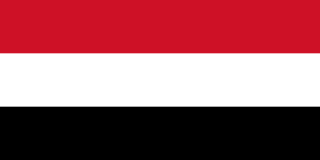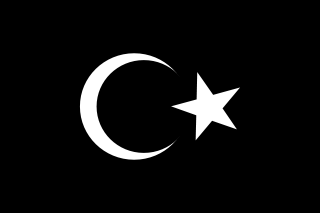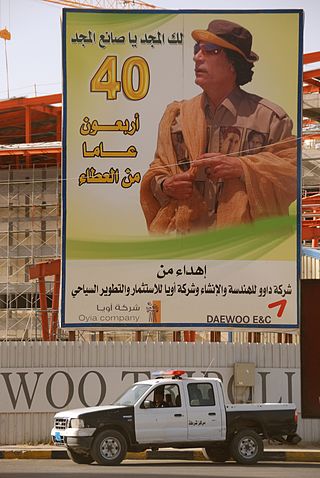
Muammar Muhammad Abu Minyar al-Gaddafi was a Libyan revolutionary, politician and political theorist who ruled Libya from 1969 until his assassination by rebel forces in 2011. He first served as Revolutionary Chairman of the Libyan Arab Republic from 1969 to 1977 and then as the Brotherly Leader of the Great Socialist People's Libyan Arab Jamahiriya from 1977 to 2011. Initially ideologically committed to Arab nationalism and Arab socialism, Gaddafi later ruled according to his own Third International Theory.

Muammar Gaddafi became the de facto leader of Libya on 1 September 1969 after leading a group of young Libyan Army officers against King Idris I in a bloodless coup d'état. After the king had fled the country, the Revolutionary Command Council (RCC) headed by Gaddafi abolished the monarchy and the old constitution and established the Libyan Arab Republic, with the motto "freedom, socialism and unity". The name of Libya was changed several times during Gaddafi's tenure as leader. From 1969 to 1977, the name was the Libyan Arab Republic. In 1977, the name was changed to Socialist People's Libyan Arab Jamahiriya. Jamahiriya was a term coined by Gaddafi, usually translated as "state of the masses". The country was renamed again in 1986 as the Great Socialist People's Libyan Arab Jamahiriya, after the United States bombing that year.

Abdessalam Jalloud is a Libyan former politician and military officer who served as the Prime Minister of Libya from 16 July 1972 to 2 March 1977, under the government of Muammar Gaddafi. He was also Minister of Treasury from 1970 until 1972.

The Revolutionary Command Council was the twelve-person governing body that ruled the Libyan Arab Republic after the 1969 Libyan coup d'état by the Free Officers Movement, which overthrew the Senussi monarchy of King Idris I. The council's chairman was Muammar Gaddafi, who had the most influence and served as Libya's de facto head of state as Revolutionary Chairman of the Libyan Arab Republic and commander-in-chief of the armed forces. It was ideologically Arab nationalist, republican, anti-imperialist and pan-Arabist.

Umar Abdullah el-Muhayshi, also transliterated as Omar al-Meheshi, was a Libyan army officer and a member of the Libyan Revolutionary Command Council that ruled Libya after the 1969 Libyan coup d'état.

The 1971 Sudanese coup d'état was a short-lived communist-backed coup, led by Major Hashem al Atta, one of the founding members of the free officers organization that carried out a coup two years prior, against the government of President Gaafar Nimeiry. The coup took place on 19 July 1971, toppling the government of the Democratic Republic of the Sudan, but failed to garner support either domestically or internationally. After several days Nimeiry loyalists launched a counter-coup, freeing Nimeiry and toppling Atta's government.

Abu-Bakr Yunis Jabr was a Libyan military officer and politician was the Libyan Secretary of the Libyan General Committee for Defence during the rule of Muammar Gaddafi. His official position was Secretary of the Libyan General Interim Committee for Defence.
The Qadhadhfa is one of the Arab Ashraf tribes in Libya, living in the Sirte District in present-day northwestern Libya. They are traditionally counted amongst the country's Ashraf tribes, and during the Gaddafi regime were regarded as being one of the greatest and most powerful tribes in the whole country. They are now mostly centered at Qasr Abu Hadi, Sirte.

From 1969 to early 2011, the politics of Libya were determined de facto by Muammar Gaddafi, who had been in power since his overthrow of the Kingdom of Libya in 1969.

The House of Shennib is one of Libya's prominent families. The House of Shennib includes notable public figures who have played a significant part in 20th century Libyan history: heads of state, ministers, authors and diplomats. The family's history is intrinsically tied with the creation of the State of Libya with members of Bayt Shennib playing prominent roles in the defeat of colonial Italian Libya, the creation of the unified Libyan state after World War II. The most notable members of the family include Omar Faiek Shennib, Ahmed Fouad Shennib, Wanis al-Qaddafi and Abdul-Aziz Shennib. The historical seat of Bayt Shennib is Derna, Cyrenaica.

The 1969 Libyan revolution, also known as the al-Fateh Revolution or 1 September Revolution, was a coup d'état and revolution carried out by the Free Officers Movement, a group of Arab nationalist and Nasserist officers in the Libyan Army, which overthrew the Senussi monarchy of King Idris I and resulted in the formation of the Libyan Arab Republic. Free Officers Movement was led by Colonel Muammar Gaddafi.
The Cultural Revolution in Libya was a period of political and social change in Libya. It started with Muammar Gaddafi's declaration of a cultural revolution during a speech in Zuwara on 15 April 1973. This came after increasing tensions between Gaddafi and his colleagues in the Revolutionary Command Council (RCC) had led him to agree to step down. Gaddafi had told the RCC that he would announce his resignation to the people at the Zuwara speech, but he instead surprised them with his declaration of the Cultural Revolution. By the end of the Cultural Revolution period, Gaddafi was the uncontested leader of Libya.

The 40th anniversary of the Libyan Revolution was a ruby jubilee anniversary in the Great Socialist People's Libyan Arab Jamahiriya celebrated on 1 September 2009 in honor of the 1969 Libyan coup d'état.
The expulsion of Italians from Libya took place following 21 July 1970, when the Libyan Revolutionary Command Council (RCC) issued a special law to "regain wealth stolen from the Libyan people by Italian oppressors", as stated by Muammar Gaddafi in a speech a few days later. With this law, Italians who had long lived in Libya were required to leave the country by October 1970.

Al-Khweldi Muhammad Salih Abdullah El-Hamedi, also transliterated as Khuwailidi al-Humaidi, was a Libyan Major General under Muammar Gaddafi, founding member of the Libyan Revolutionary Command Council, and the first Secretary General of the Libyan Popular National Movement. He was part of Gaddafi's inner circle.
Bashir Saghir Hawadi, also transliterated as Hawady or Houadi, is a Libyan major general who served under Muammar Gaddafi. He was among the twelve original members of the Libyan Revolutionary Command Council, the chief judge of the Libyan People's Court, and the General Secretary of the Arab Socialist Union.

Mustafa al-Kharoubi, also transliterated as Kharubi, was a Libyan general and politician under Muammar Gaddafi. He was part of Gaddafi's inner circle.
Abdel Moniem al-Taher al-Houni, also transliterated as Abdul Munim el-Huni, is a Libyan military officer, diplomat, and politician. He was one of the original twelve members of the Libyan Revolutionary Command Council and briefly served as Minister of Foreign Affairs from 1974 to 1975.

Mohammed Emhamed Awad Najm was a Libyan military officer and political figure. He was one of the original twelve members of the Libyan Revolutionary Command Council and also served as Foreign Minister.

The Free Officers movement was a group of Arab nationalist and Nasserist officers in the Libyan Army that planned and carried out the 1969 Libyan coup d'état, which overthrew the Senussi monarchy of King Idris I, ending the Libyan monarchy. It was led by a twelve-member cabinet known as the Revolutionary Command Council, whose chairman was Muammar Gaddafi, which came to govern the Libyan Arab Republic.














